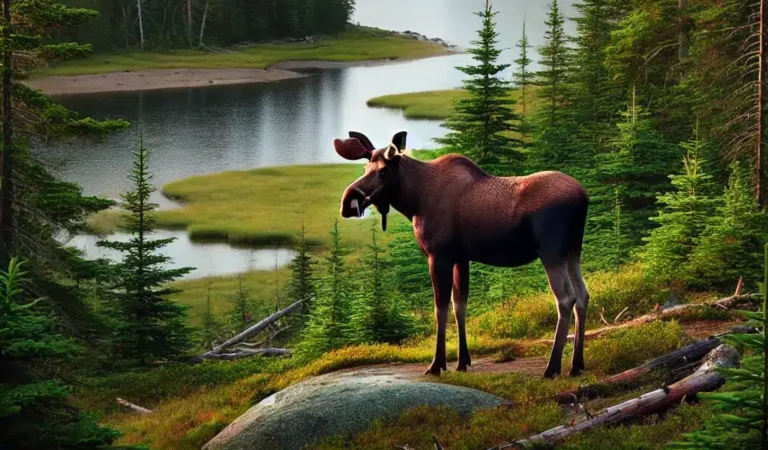Few are as awe-inspiring as the moose when it comes to the majestic creatures of the wild. One of their most striking features is undoubtedly their large and impressive antlers. These towering structures can reach up to six feet widths and weigh as much as 40 pounds! But what is the significance of these antlers, and how often are moose antlers shedding?
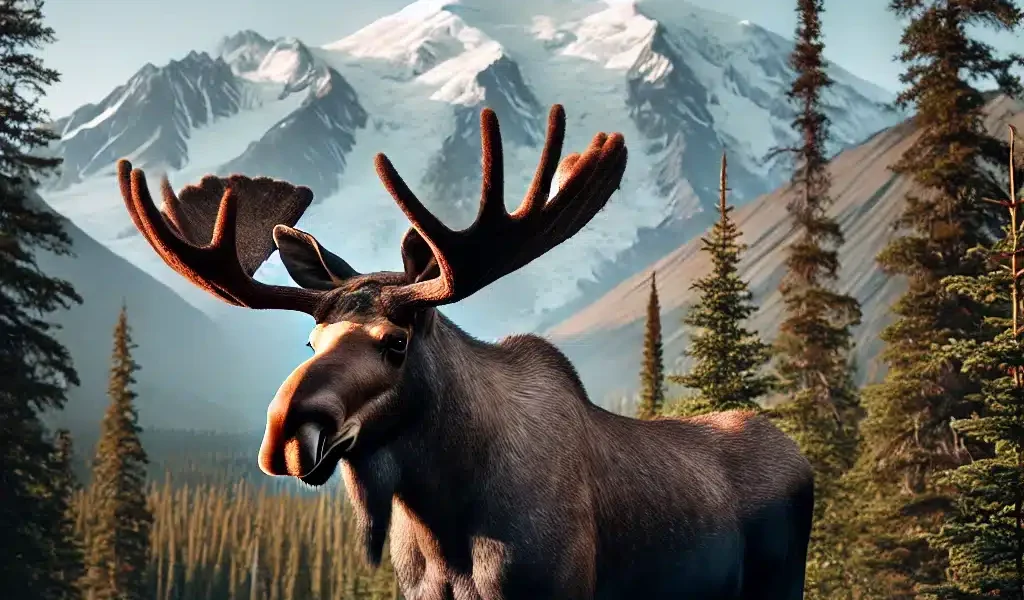
Moose antlers are not only a symbol of power and dominance, but they also serve several essential functions in a moose’s life. Antlers are made up of bone tissue and grow from pedicles and bony structures on top of a moose’s head.
During the summer months, when growth is most active, moose antlers are covered in a soft, velvety substance filled with blood vessels that nourish them. This velvet covering dries up and falls off as autumn approaches, revealing the hardened structure beneath.
Explanation of Why Moose Shed Their Antlers
Now that we understand what makes moose antlers special, let’s investigate why these magnificent creatures shed them. Unlike horns found in animals like cattle or sheep that grow throughout an animal’s lifetime, moose antlers have a cyclical growth process known as the ‘moose antler lifecycle.’
Every year, usually during late fall or early winter after mating season ends, male moose, also known as bulls, begin shedding their antlers.
The primary reason behind this shedding process lies in energy conservation. Maintaining those massive antlers requires significant amounts of energy and resources from a moose’s body.
When food becomes scarce during harsh winters when vegetation is limited or covered by snowfall, it becomes crucial for moose to conserve their energy and redirect it towards survival. Shedding antlers allows them to do just that, enabling them to navigate through the winter with less strain on their bodies.
The Shedding Process
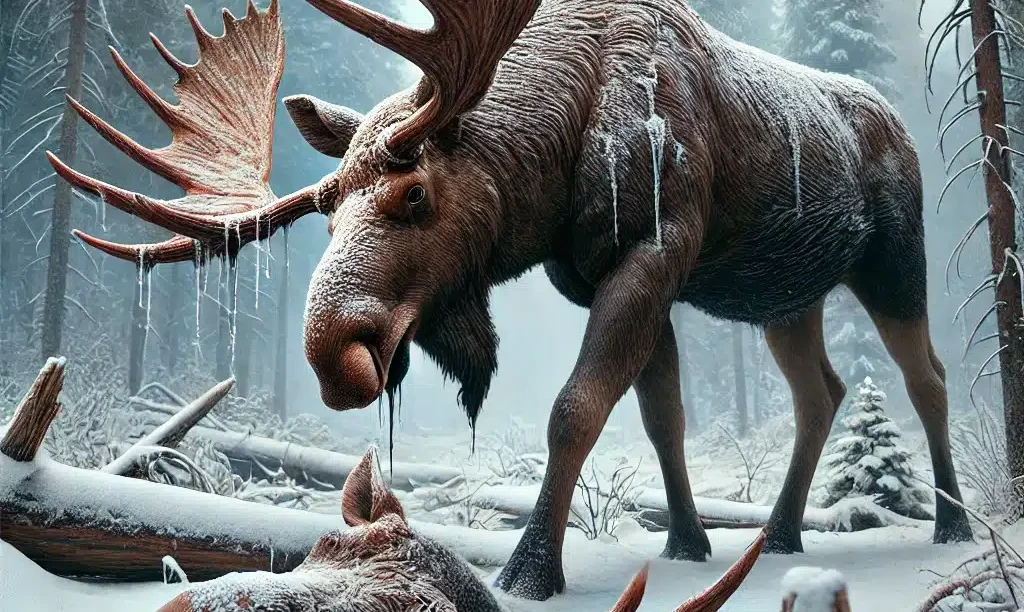
Timing and frequency of antler shedding in moose
When shedding their majestic antlers, moose have their unique timeline. The timing can vary depending on various factors, such as the species of moose and its geographical location. Most moose start shedding their antlers in late fall or early winter.
However, it’s important to note that not all moose shed their antlers simultaneously; it can be staggered over several weeks. The frequency of shedding is an annual occurrence for adult male moose, while younger ones may shed their smaller antlers more frequently as they grow.
Factors influencing the shedding process (age, health, nutrition)
Several factors influence the shedding process of moose antlers. Age plays a significant role; older males tend to shed their antlers earlier than younger bulls. Health is another factor that affects the timing and quality of shed antlers – stronger and healthier individuals often have a more consistent schedule for dropping their antlers.
Additionally, nutrition plays a vital role in the growth and subsequent shedding of antlers in moose. A well-nourished bull generally has healthier and larger antler racks than those with poor nutrition.
Signs indicating that a moose is about to shed its antlers
Observant nature enthusiasts can often spot signs that indicate when a moose is about to shed its magnificent crown of antlers. As the season approaches for them to drop their headgear, you may notice behavioral changes in male moose. They might become more restless or agitated than usual due to hormonal shifts within their bodies.
Physical signs include increased rubbing against trees or shrubs – this rubbing action helps accelerate the loosening process between the pedicle (the bony attachment point) and the antler. If you spot a male moose with antlers showing signs of discoloration, cracking, or visible damage, it could be a sign that they are preparing to shed them soon.
Antler Growth Cycle
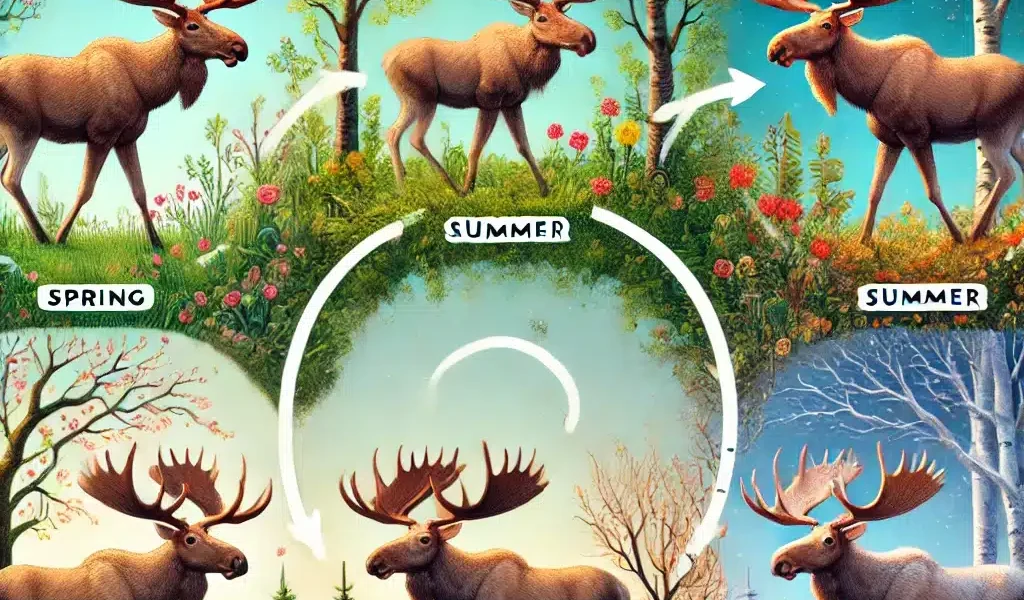
Detailed Explanation of the Different Stages in the Growth Cycle
The moose antler lifecycle consists of three distinct stages: the velvet stage, the hardening stage, and the rutting stage. Each stage plays a crucial role in the growth and development of these majestic appendages.
Velvet Stage: Rapid Growth and Nourishment of Antlers
During the velvet stage, typically from late spring to early summer, moose antlers experience remarkable growth. “velvet” refers to the soft layer of skin covering the growing antlers.
Beneath this protective layer, blood vessels supply vital nutrients, including calcium and minerals necessary for rapid growth. This phase is critical for establishing a strong foundation and size for future dominance battles during mating season.
Hardening Stage: Mineralization and Hardening of Antlers
Following the velvet stage, as summer progresses into early fall, moose enter what is known as the hardening stage. During this period, antlers undergo mineralization, depositing calcium and other minerals to strengthen their structure.
Blood flow to the antlers decreases as they lose their velvet covering. The antlers gradually transform from soft and spongy into solid bone-like structures capable of withstanding aggressive clashes between rival males.
Rutting Stage: Peak Strength and Size of Antlers for Mating Battles
The rutting stage marks the culmination of a moose’s antler growth process as it reaches its peak strength and size. This coincides with autumn when breeding opportunities arise. Male moose engage in fierce competitions to establish dominance over potential mates by engaging in intense battles using their impressive antlers.
The size, number of tines (branches), shape, and overall condition of an individual’s antlers play a significant role in determining their success during this mating period. By understanding the intricacies of the moose antler growth cycle, we gain insight into the incredible transformation these magnificent creatures undergo to thrive and assert their dominance during mating season.
Physical Characteristics of Shed Antlers
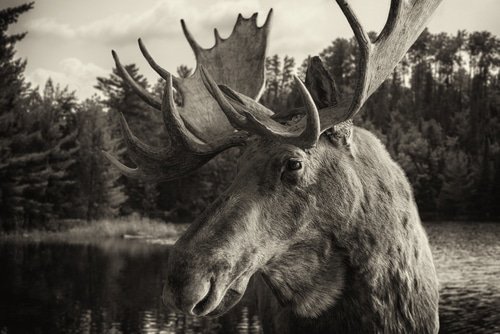
Size, Weight, and Shape Variations Among Different Moose Species
When it comes to moose antlers, one size does not fit all! These majestic creatures display remarkable size, weight, and shape variations across different species.
For instance, the Alaskan moose boasts the largest antlers among all subspecies, with an average spread of 65 inches or more! On the other hand, the Shiras moose from North America’s Rocky Mountains tends to have comparatively smaller antlers with an average spread of around 40 inches.
The variation doesn’t stop there – some moose may even have oddly shaped antlers due to genetic factors or injuries. So, whether you encounter a massive palmate spread or sleek and slender tines, each set of shed antlers tells a unique story about the particular moose they once belonged to.
Anatomy and Structure of a Shed Antler (Pedicle, Beams, Tines)
Let’s dive into their intricate anatomy and structure to appreciate the beauty of shed moose antlers truly. It all starts at the pedicle – where these magnificent headpieces are attached to a moose’s skull.
The pedicle acts as a sturdy base from which two main beams emerge upward and outward. These beams then branch out into individual tines, which can vary in number depending on genetics and age.
These tines can be likened to fingers on a hand – they give each set of shed antlers its unique character and personality! Every detail showcases nature’s artistic craftsmanship, from brow tines near the base that curve gracefully upwards to long main beams stretching outwards like majestic tree branches adorned with secondary tines.
Purpose and Benefits of Antler Shedding
Resource Allocation: Conserving Energy during Harsh Winters
Picture this: a majestic moose, its antlers reaching toward the sky, navigating through the snow-covered wilderness. As winter descends upon the land, food becomes scarce, and temperatures drop to bone-chilling levels.
In these challenging times, a moose must conserve energy to survive. Shedding its antlers comes to the rescue as a smart strategy for resource allocation.
With no longer needing to sustain those massive appendages on its head, the moose can redirect its energy towards finding food and staying warm. By shedding their antlers in late fall or early winter, these remarkable creatures enhance their chances of survival during nature’s harshest season.
Regeneration: Allowing for New Growth with Improved Quality
The process of shedding antlers not only serves as an energy-saving mechanism but also paves the way for new growth and improved quality in subsequent cycles. Once shed, moose antlers undergo a remarkable transformation involving scratch regrowth.
This regeneration allows fresh, stronger antlers to form each passing year. The growth process begins initially but gradually accelerates as nutrients are channeled towards this purpose.
Interestingly enough, older moose tend to have more impressive antlers due to years of accumulated growth experience. Through regeneration, moose continually enhance their formidable headgear’s size and strength, enabling them to engage in fierce battles during mating season and assert dominance amongst their peers.
So there you have it – shedding antlers conserves vital resources during harsh winters and gives rise to an ongoing cycle of renewal and improvement within moose physiology. This natural phenomenon adds yet another captivating layer to the awe-inspiring world of these magnificent creatures – the moose.
Ecological Significance
Role in forest ecosystem as a source of calcium for other animals
Apart from their majestic appearance, moose antlers serve a crucial role in the forest ecosystem by providing a valuable source of calcium for other animals. As moose shed their antlers, these discarded treasures become readily available to scavengers and herbivores alike. Small mammals like rodents and porcupines gnaw on the antlers to obtain the much-needed calcium essential for bone development and overall health.
Additionally, birds such as jays and woodpeckers use the shed antlers as perches or nesting material. Thus, the shedding process benefits moose and contributes to the nutrition and survival of various forest-dwelling creatures.
Impact on plant diversity through browsing habits
The browsing habits of moose during their annual antler growth process significantly influence plant diversity within their habitat. Moose are known as selective browsers and have a particular fondness for woody vegetation such as shrubs and saplings. As they consume these plants during summer and winter, they create openings in the forest understory that allow sunlight to reach the ground.
This sunlight stimulates the growth of herbaceous plants like ferns, grasses, and wildflowers that thrive in these exposed areas. By shaping the vegetation landscape through their browsing habits, moose increase plant diversity by fostering a variety of species that may not have otherwise flourished beneath dense canopies.
In this way, moose play an important role in maintaining a balanced ecosystem. By fulfilling these ecological roles through their shedding process and browsing habits, moose demonstrate how interconnected species contribute to their natural environment’s overall health and biodiversity.
Cultural Significance
Traditional uses by indigenous peoples for tools and crafts
Throughout history, indigenous peoples have relied on every part of the moose for sustenance and practical purposes. The shedding moose antlers have been particularly valuable in crafting various tools and objects. Indigenous communities would skillfully carve antlers into handles for knives, awls, scrapers, and even spearheads.
The durability and strength of moose antlers made them ideal for creating these essential implements for survival in their harsh environments. These pieces’ intricate designs and craftsmanship highlight indigenous cultures’ deep reverence for the majestic creatures that provided them with such versatile resources.
Symbolism in folklore, art, and literature
Moose antlers hold great symbolic significance in folklore, art, and literature across different cultures. In some ancient mythologies, moose were considered sacred animals associated with wisdom, strength, and protection.
Their majestic antlers became a symbol of power and dominance. In folktales and oral traditions passed down through generations, tales about mighty moose with extraordinary antlers often served as cautionary lessons or represented divine intervention.
This symbolism continues to inspire contemporary artists who use moose antlers as a motif to convey strength or evoke a connection to nature’s grandeur. Moreover, writers have utilized the imagery of shedding antlers as metaphors for personal growth or transformation within their literary works.
Conservation Efforts & Management Practices
Monitoring populations through tracking sheds
One of the key aspects of conservation efforts for moose antler shedding is monitoring their populations. This is where tracking sheds come into play.
Shed antlers serve as valuable clues to estimate the number and distribution of moose in a specific area. Wildlife biologists and researchers collect these shed antlers, referred to as “sheds,” from the natural habitats of moose.
By carefully examining these sheds, they can gather crucial insights into different moose populations’ health, age structure, and genetics. Furthermore, tracking sheds allow scientists to monitor changes in moose population dynamics over time.
By analyzing patterns in the size and quality of shed antlers, researchers can better understand factors such as nutrition availability, habitat conditions, and overall population sustainability. This information is essential for implementing effective conservation strategies and ensuring the long-term viability of moose populations.
Importance of protecting habitat for healthy antler growth
Protecting habitat plays a vital role in supporting healthy antler growth in moose. Moose depend on specific environments that provide adequate food sources during critical periods like the antler growth process.
Sustainable management practices focus not only on conserving moose themselves but also on preserving their habitats. Preserving suitable habitats ensures abundant food sources like aquatic plants, shrubs, and trees, which are crucial for optimal nutrition during the growing stages of antlers.
Additionally, maintaining quality habitat facilitates successful mating opportunities during rutting season when males rely on their impressive antlers to establish dominance. Implementing measures like controlling human activities such as logging or development near important moose habitats helps minimize disturbances that could disrupt natural cycles or reduce available resources.
Protecting these areas allows for undisturbed access to food and minimizes stressors that might hinder healthy antler growth. Monitoring moose populations through tracking sheds provides valuable insights into their numbers, health, and genetics.
Moreover, protecting their habitats is crucial for ensuring optimal antler growth and overall population sustainability. By combining these conservation efforts with effective management practices, we can contribute to the long-term well-being of these majestic creatures and preserve the beauty of the moose antler lifecycle for future generations to enjoy.
Conservation Efforts & Management Practices
Monitoring populations through tracking sheds
Tracking the shedding process of moose antlers plays a vital role in monitoring and understanding the health of moose populations. Conservationists and researchers often collect shed antlers to estimate population densities, sex ratios, and age structure.
Experts can gain insights into the overall reproductive success and genetic diversity within a population by examining these sheds. This information helps guide wildlife management strategies to ensure the long-term sustainability of moose populations.
Importance of protecting habitat for healthy antler growth
Protecting moose habitats ensures healthy antler growth and overall population well-being. These magnificent creatures require diverse ecosystems that provide ample food sources, including nutrient-rich vegetation, for optimal antler development.
Conservation efforts focus on preserving and restoring critical habitats such as wetlands, forests, and meadows where moose thrive. By safeguarding these areas from human encroachment, habitat degradation, or climate change impacts, we can guarantee that future generations will continue to witness the impressive beauty of fully-grown and regenerating moose antlers.
Conclusion
The process of moose antler shedding is an extraordinary phenomenon in nature. From their remarkable growth cycle to their ecological significance in providing calcium to other animals and influencing plant diversity through browsing habits, these majestic creatures hold a significant place in our natural world.
Furthermore, the cultural significance they possess through traditional uses by indigenous peoples and their symbolism in folklore, art, and literature cannot be overlooked. As we delve deeper into understanding the intricate details of the moose antler lifecycle and growth process, conservation efforts become increasingly crucial for maintaining healthy populations.
Monitoring them through tracking sheds provides valuable insights into population dynamics while protecting their habitats, ensuring optimal antler growth and overall well-being. By acknowledging the awe-inspiring nature of moose antlers and actively working towards their preservation, we can contribute to conserving these magnificent creatures and appreciate the beauty they bring to our world.


